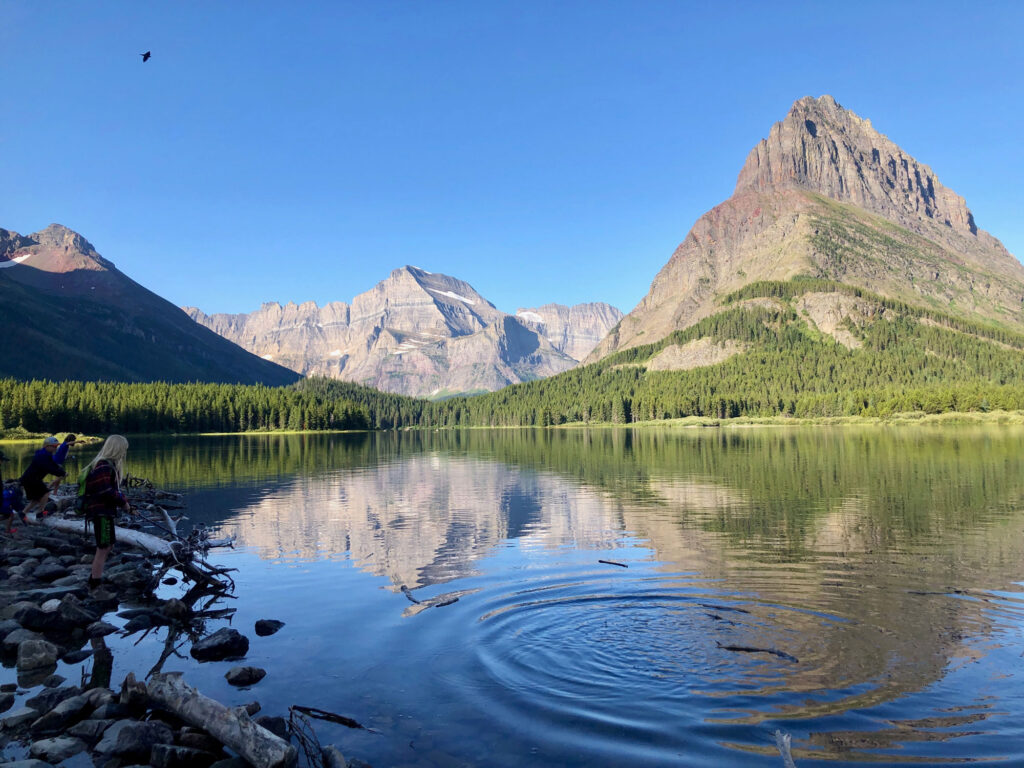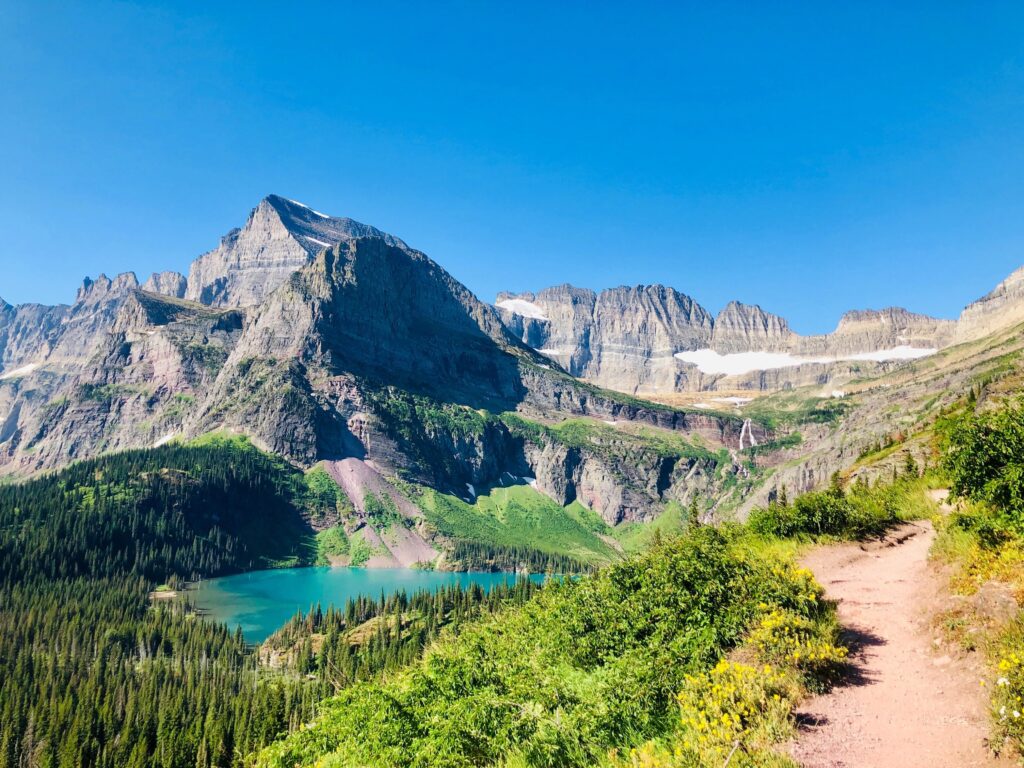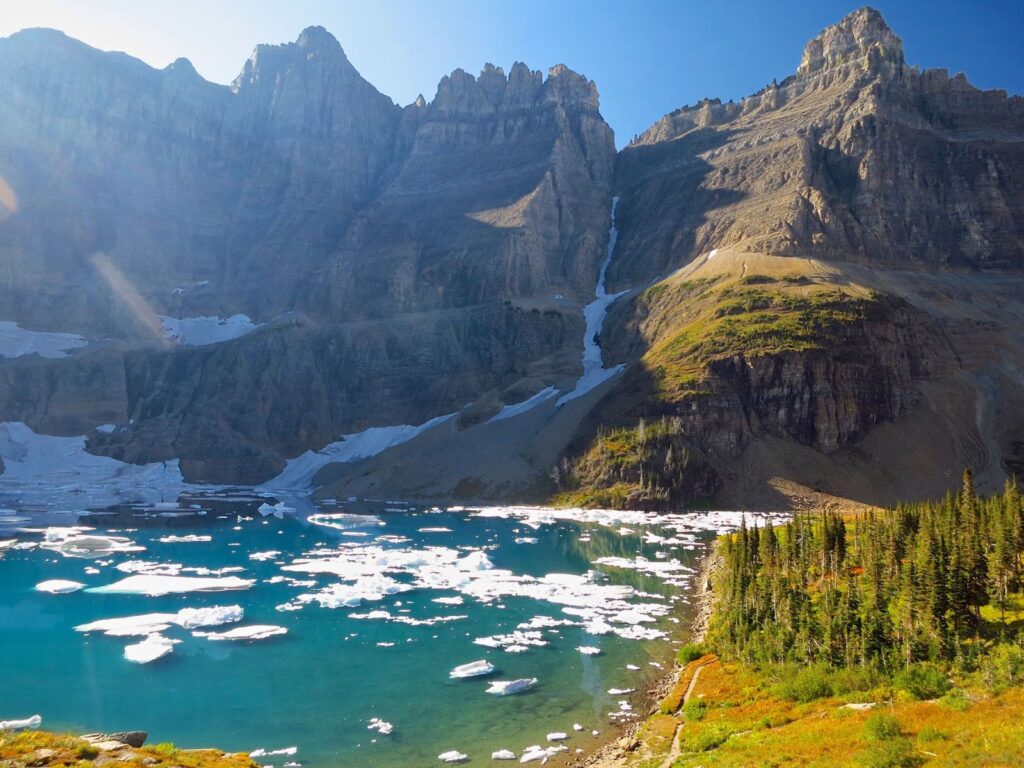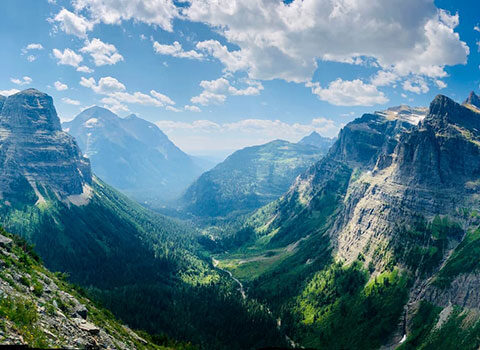Grinnell Glacier
If your Glacier National Park dream is to see a glacier up close and personal, hiking to Grinnell Glacier is an absolute must! Outstanding vistas, alpine meadows, and the park’s only glacier fairly easily accessible by trail make this steep trek worth every step. There are two ways to approach Grinnell Glacier: on foot or partially by boat
Hike Profile
Glacier Guide Difficulty Rating: Strenuous
Elevation Gain: 1600 ft. (488 m)
Mileage: 10.6 miles (17 km); take 3.4 mi (5.5 km) off the round trip by taking a boat ride, for a total trip of 7.2 miles.
Hiking Time (estimate): 3½ to 4 hours to Grinnell Glacier, 1 hour for lunch, and 3 hours for return.
Other: This trail is very exposed! Proper sun, wind, and rain protection are necessary. Trekking poles are recommended. To shorten this hike, take the Glacier Boat Company boat tour across Swiftcurrent Lake and Lake Josephine. Make reservations far in advance to guarantee a spot.
Logistics
Trailhead: Grinnell Glacier Trailhead (4,925 ft.)
Bathrooms: Bathrooms at the trailhead. Pit toilets located a 1/4 mile from the glacier basin.
Water: Potable water pump at the trailhead picnic area.
Parking: Grinnell Glacier Trailhead in Many Glacier.
Travel Time: 2 hours and 30 minutes/114 miles from GNP West Entrance via Route 2; 45 minutes/21 miles from the East Entrance.

The entirety of the trail is 10.6 miles. The Glacier Park Boat Company boat service shaves off 3.4 miles, cutting your roundtrip trek to 7.2 miles. Whether you walk or boat, the elevation gain will be about the same. Either choice is great: the Grinnell Glacier trail is stunning!
If you take the boat option, you’ll board the first boat in front of the Many Glacier Hotel on Swiftcurrent Lake. You’ll then walk a short, partially paved path to the second boat, on Lake Josephine.
If you decide against the boats, the easiest way to go is from the Grinnell Glacier trailhead, which is about halfway in-between the Many Glacier Hotel and Swiftcurrent Motor Inn. First, walk through a small aspen forest. Keep your eyes open – some of these aspens have black bear claw marks embedded in their bark. Beavers chopped down others in a conical fashion.
After circumnavigating Swiftcurrent Lake, keep right on the paved trail towards Lake Josephine. The foot of Lake Josephine is a great spot for a quick rest and photo.
Grinnell Geology
Notice the dark black band across the center of Mount Gould, the prominent peak framing Lake Josephine. Mt. Gould is part of the Continental Divide. The band is a diorite sill intrusion, a 100 foot thick dark band of igneous rock. This sill formed 750 million years ago when molten rock oozed up from the earth’s mantle and spread across a weak layer of Siyeh Limestone. Heat from the intrusion recrystallized the limestone surrounding the sill into marble, known as ‘contact metamorphism.’ In looking closely at the diorite band, notice the lighter low grade marble on both sides of the sill.
Next, from the foot of Josephine, continue on the Grinnell Glacier trail around the north side of the lake. Winter and spring avalanches off of the south flank of Grinnell Point prevent most trees from growing on this side of the lake. Heads up: the sun loving, grassy vegetation of cow parsnip and huckleberries make this area prime grizzly habitat!
Grinnell Lake and Falls
Traverse the north side of the lake until you reach a junction. Continue uphill and to the right to maintain course to the glacier. Down and left takes you to the head of Lake Josephine and its corresponding boat dock — which is where you’ll come up from if you take both boats. After two miles of hiking, enjoy views of the famous turquoise Grinnell Lake in the valley below!

Grinnell Falls tumbles hundreds of feet down the headwall into the lake below. Although still out of sight, Grinnell Glacier is nestled in the basin just above the falls. Look for the few areas of shade to relax, snack, and enjoy the views of Gem and Salamander glacier.
Side Note: George Bird Grinnell
Let’s talk about the history behind the name “Grinnell.” George Bird Grinnell was an influential leader in Glacier National Park history who “discovered” the glacier in 1885. Grinnell is best remembered for advocating for the creation of a national park. He saw his efforts rewarded in 1910 when President Taft signed the bill establishing Glacier as the county’s 10th national park.
Glaciers!
Gem “Glacier” is the small circular ice field to the upper left of the Grinnell Glacier Basin, while Salamander is the skinny horizontal ice field above the basin. Gem “Glacier” is no longer 25 acres in area, so it has been reduced to a “permanent snowfield.” As of 2015, only 26 official glaciers remain in the park, and over the last 50 years the average glacier area reduction is 39% (USGS). All glaciers in Glacier National Park are expected to melt within this century.
Waterfalls
The trail continues to climb and twist through beautiful alpine meadows. Expect to get wet, especially in early summer, when walking under small waterfalls tumbling down the cliffs above. About 4.5 miles from the trailhead, the trail will slightly descend before climbing again. Keep an eye out for bighorn sheep and mountain goats uphill to your right. These ungulates love munching on fresh green shoots in the meadows above.
At the rest area, fuel up for your last push to the glacier basin. Next, use the pit toilets here – there are none in the basin. The last quarter mile is a steep ascent along a boulder-strewn glacial moraine. Look back for views of Lake Sherburne in the far distance.
Arriving at Grinnell
Upon reaching the top of the old moraine, you are welcomed by commanding views of the glacier below. Grinnell Glacier is an astounding sight, regardless of its 45 percent decrease in area since 1966. Here is a unique opportunity to see fresh rock uncovered by a glacier after thousands of years under ice, and the first succession of plant life slowly dominating it.
Walk down to the glacier tarn, the body of water formed by the melting glacier, and enjoy your lunch! As you soak in the views, notice the glacial striations, or scratch marks, in the rock left by Grinnell Glacier long ago.

Finally, after you’ve had your fill of exploring the Grinnell Glacier basin, retrace your steps to the trailhead.
Let’s Go To Grinnell Glacier!
Would you like to go with a guide? Inquire about a Custom Day Hike – but be aware that we have limited availability and that they tend to book up quickly! Book in winter or early spring for best availability.
Compiled by Guide Sara Edwards
Photos by Courtney Stone

